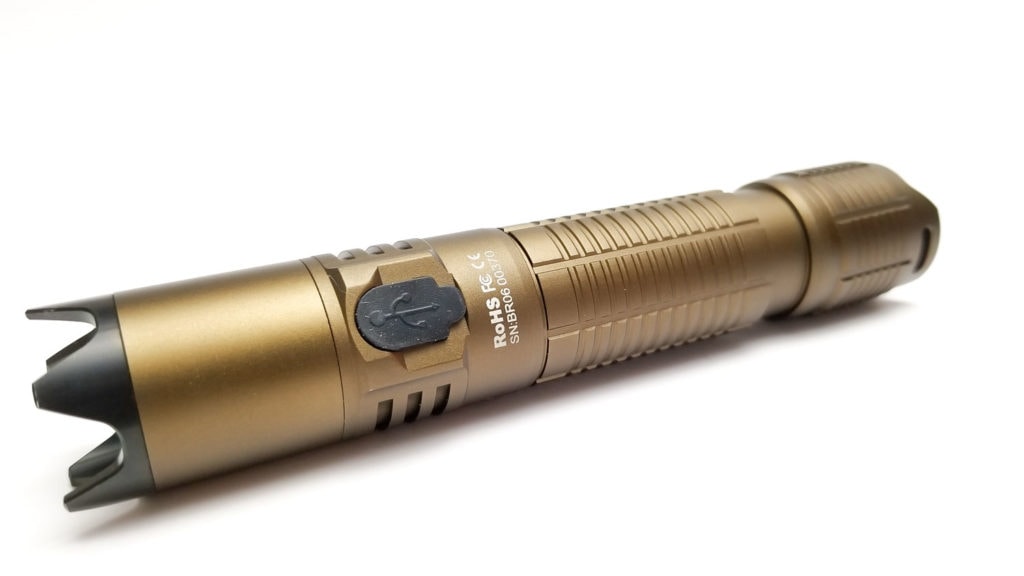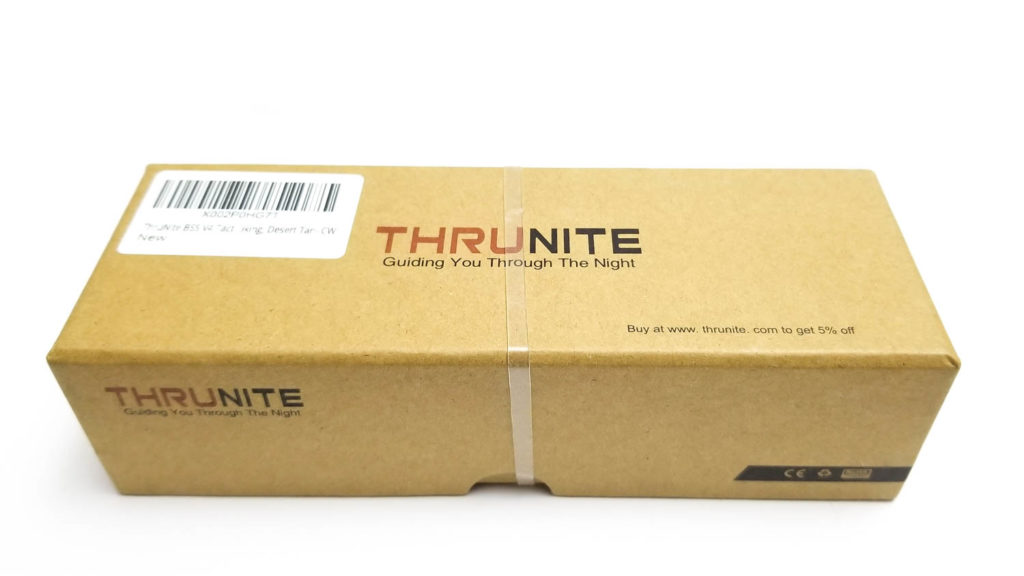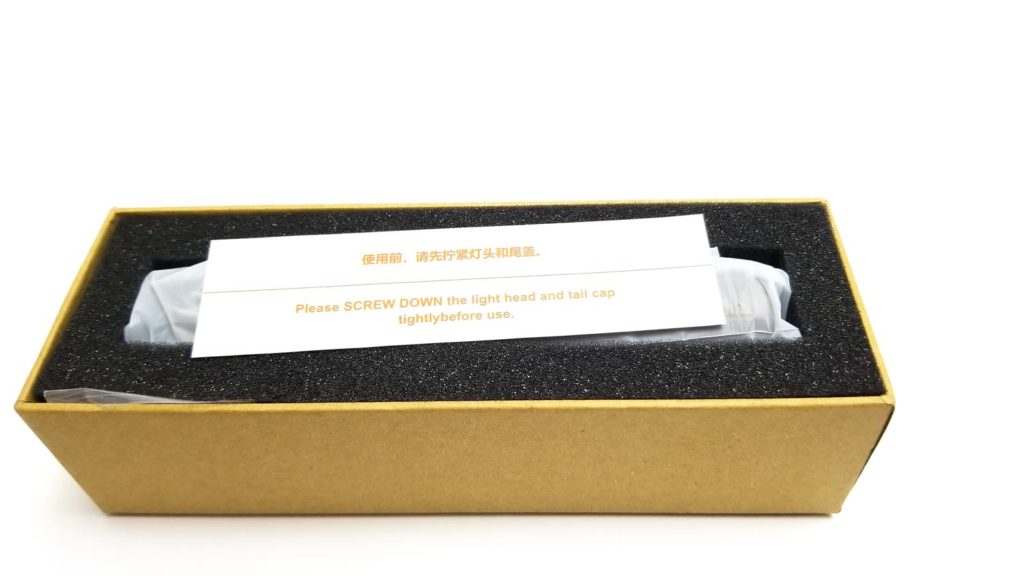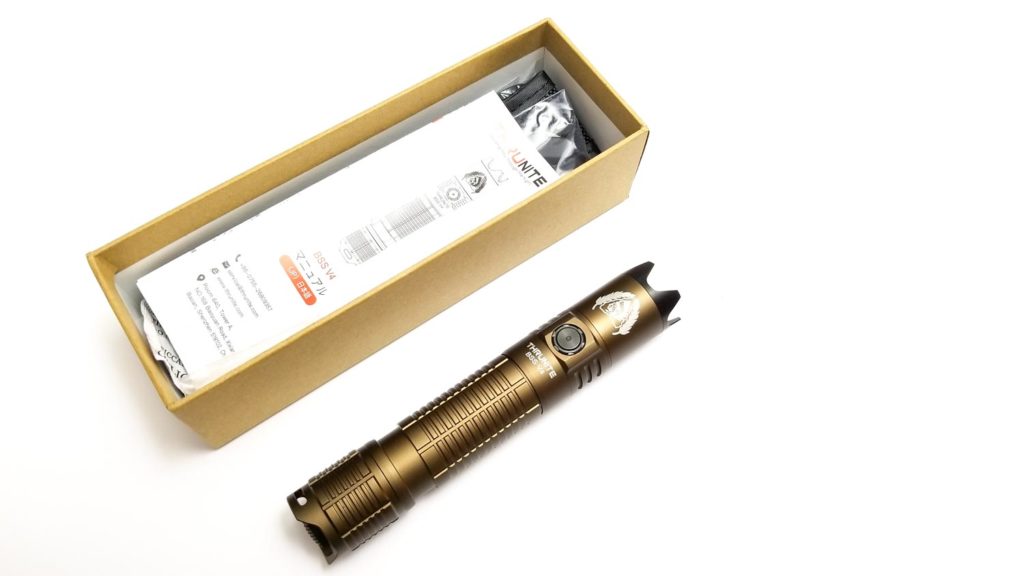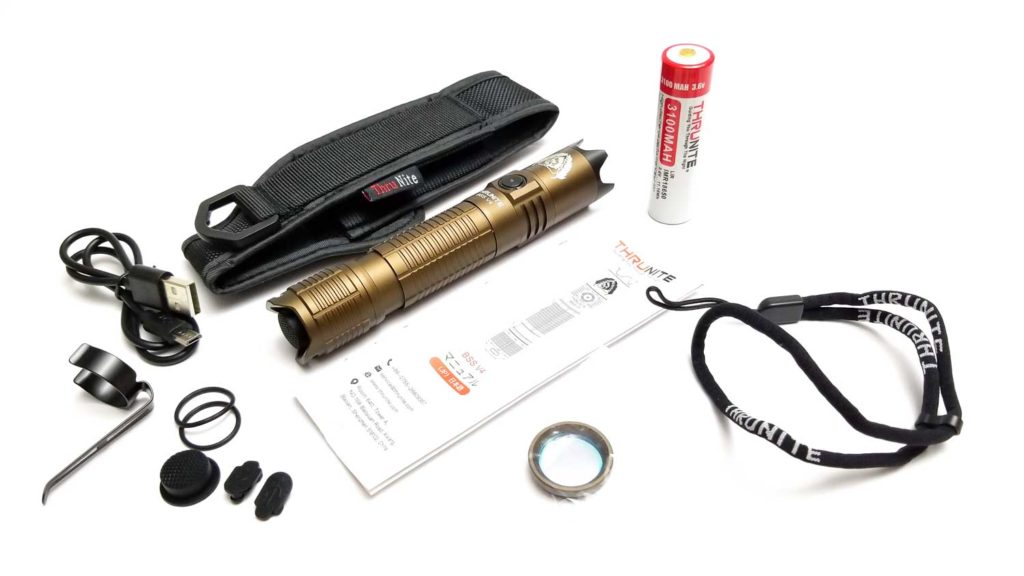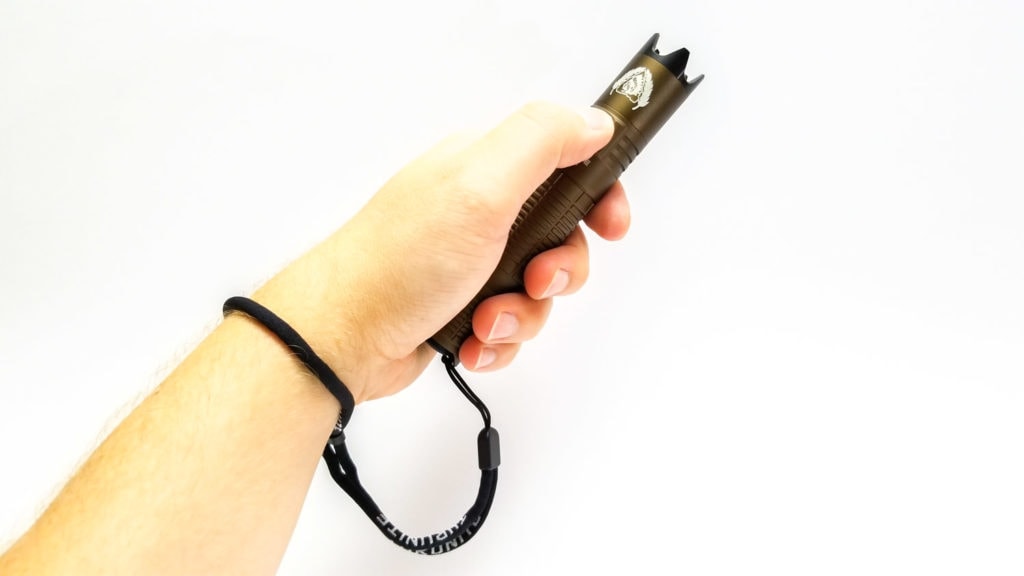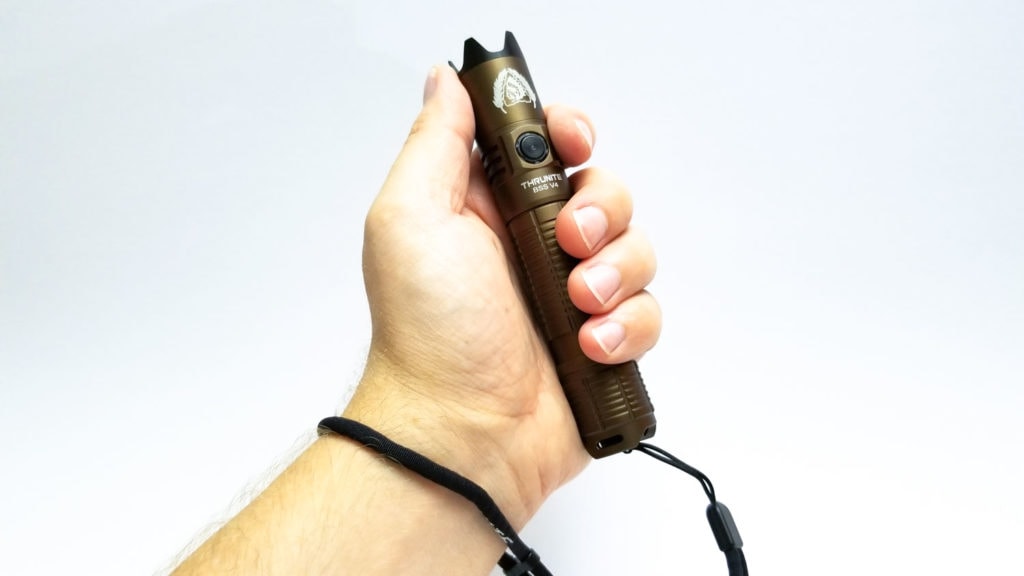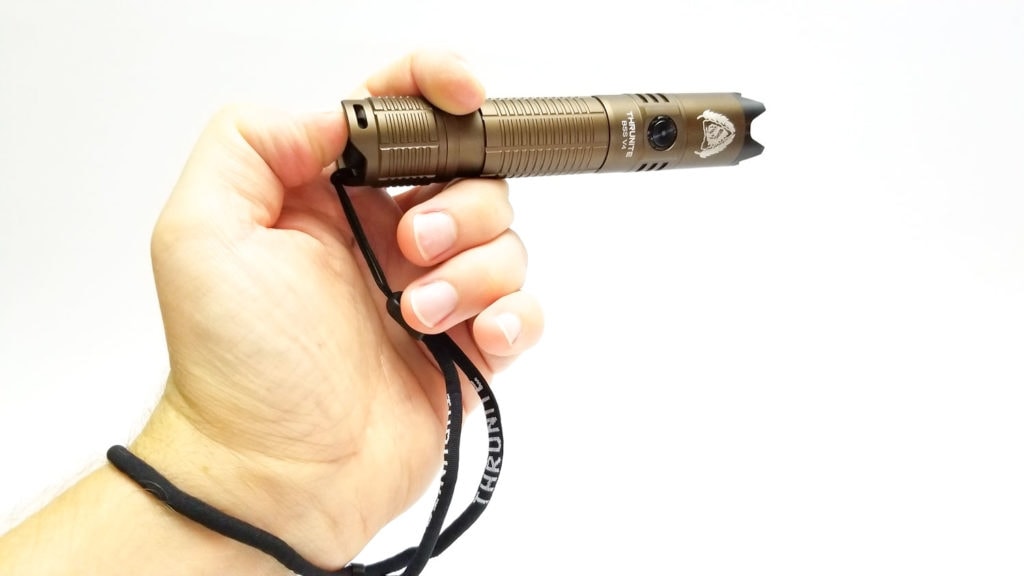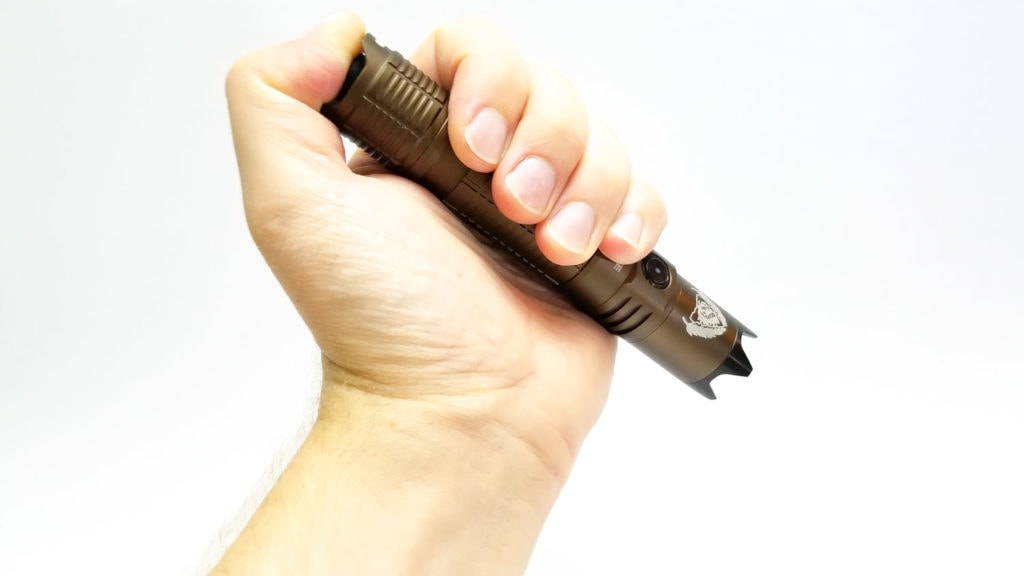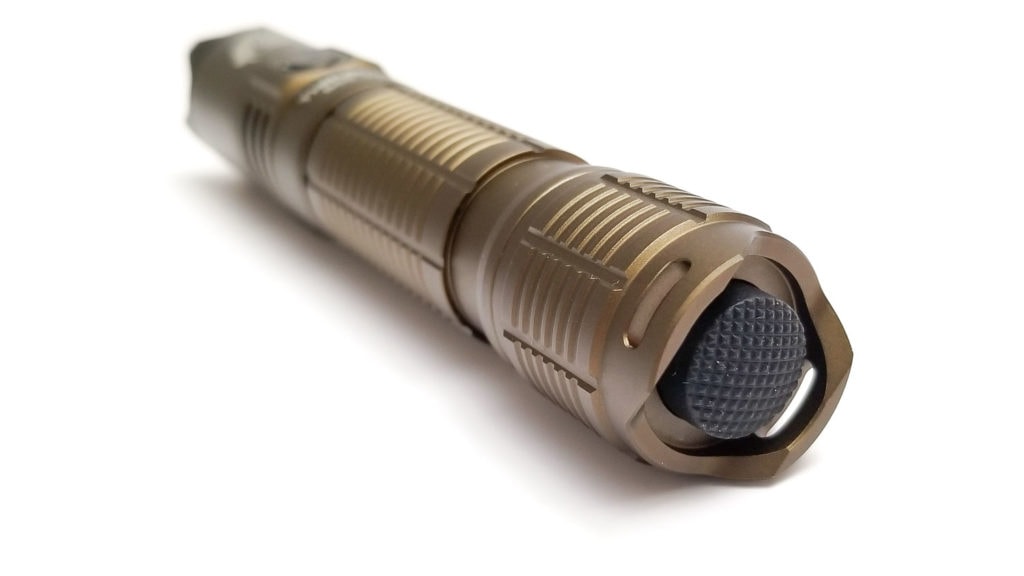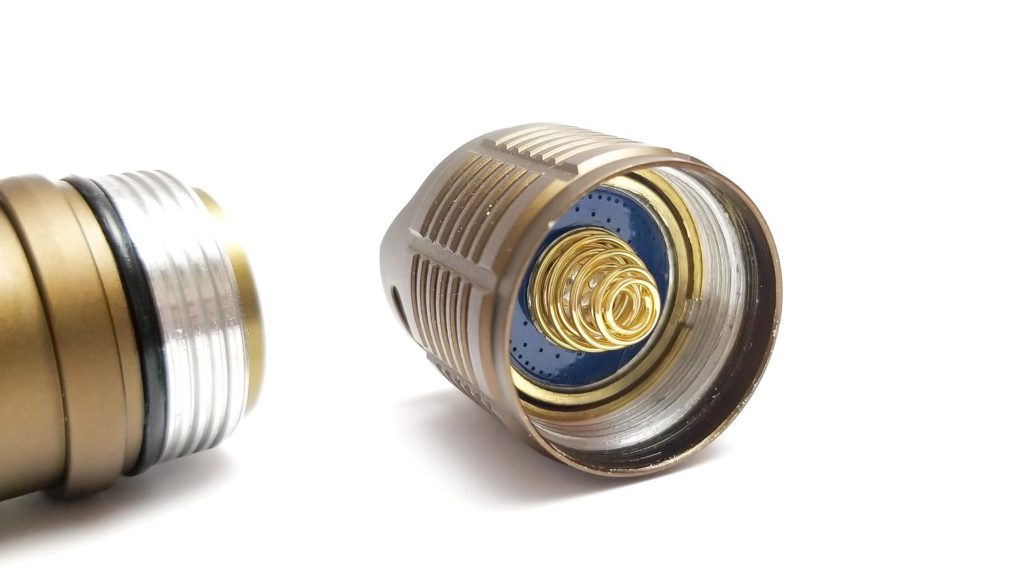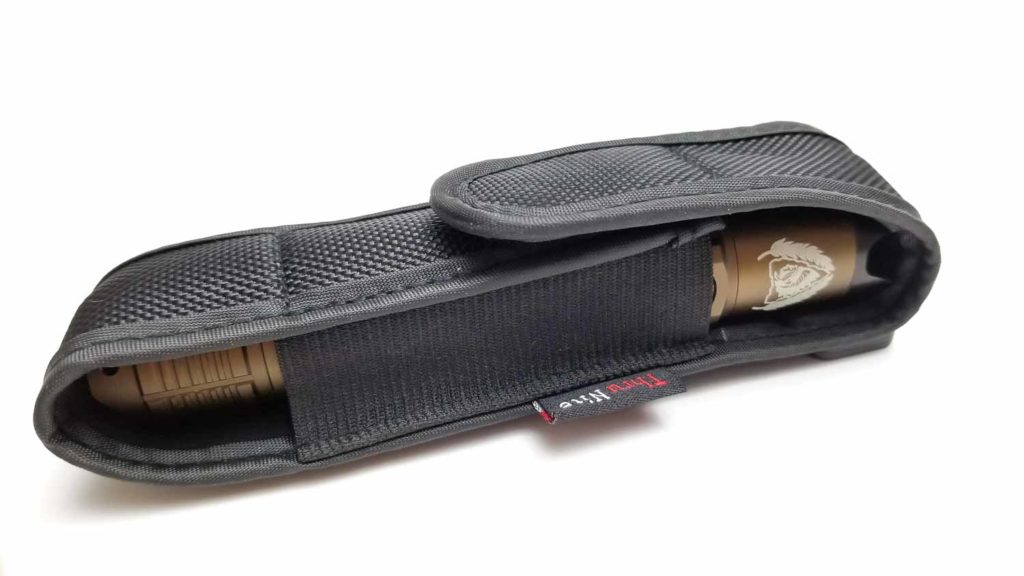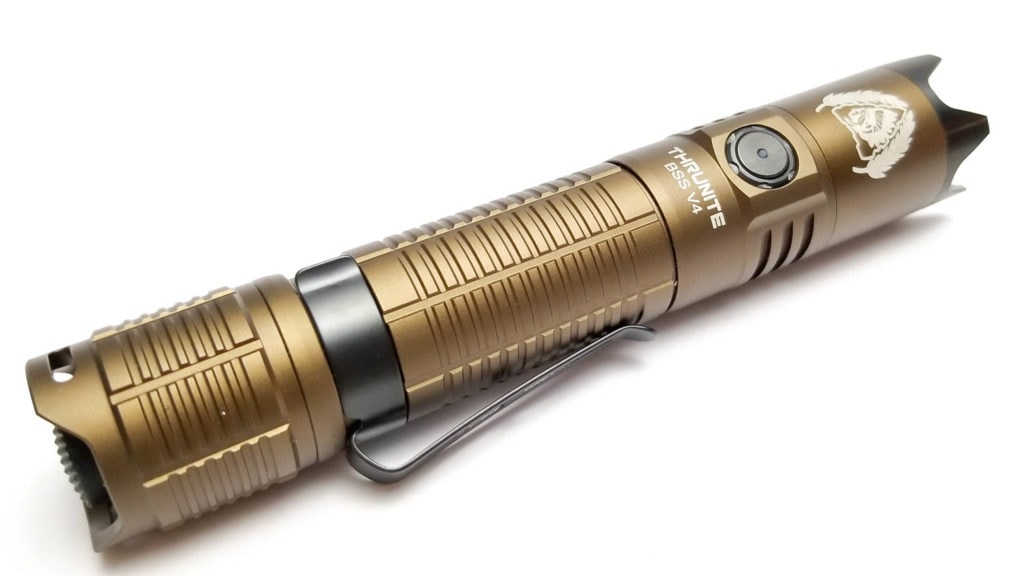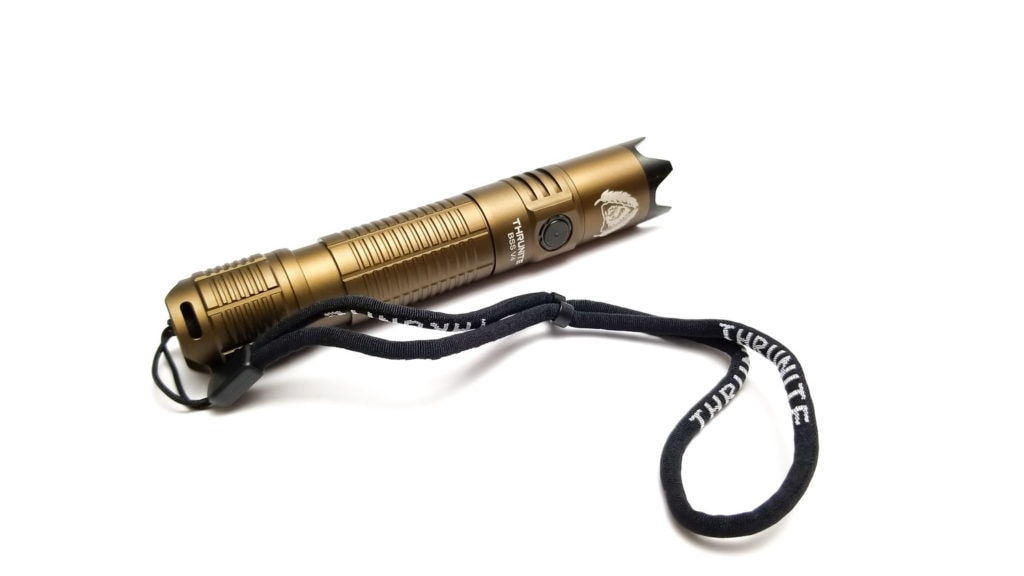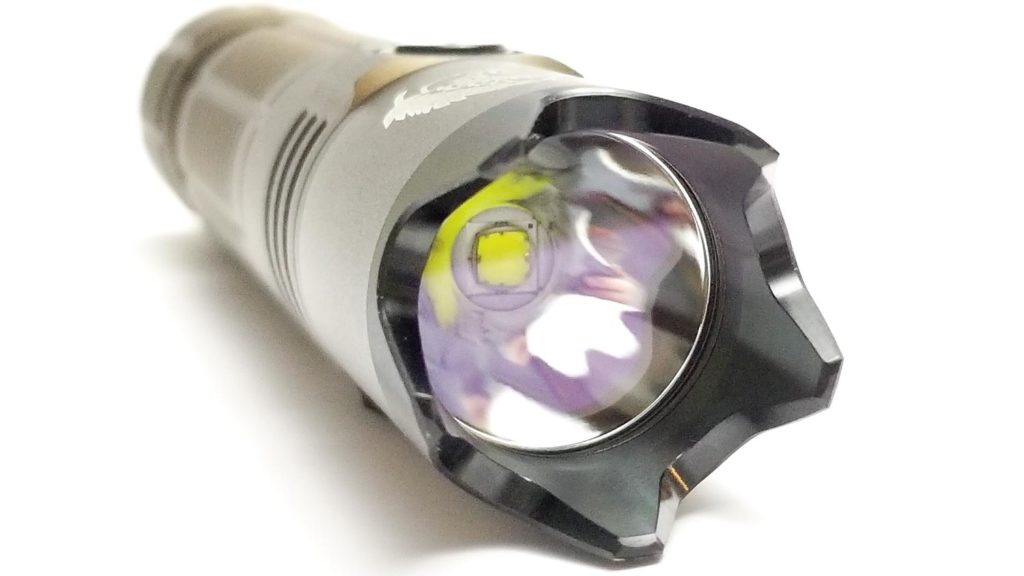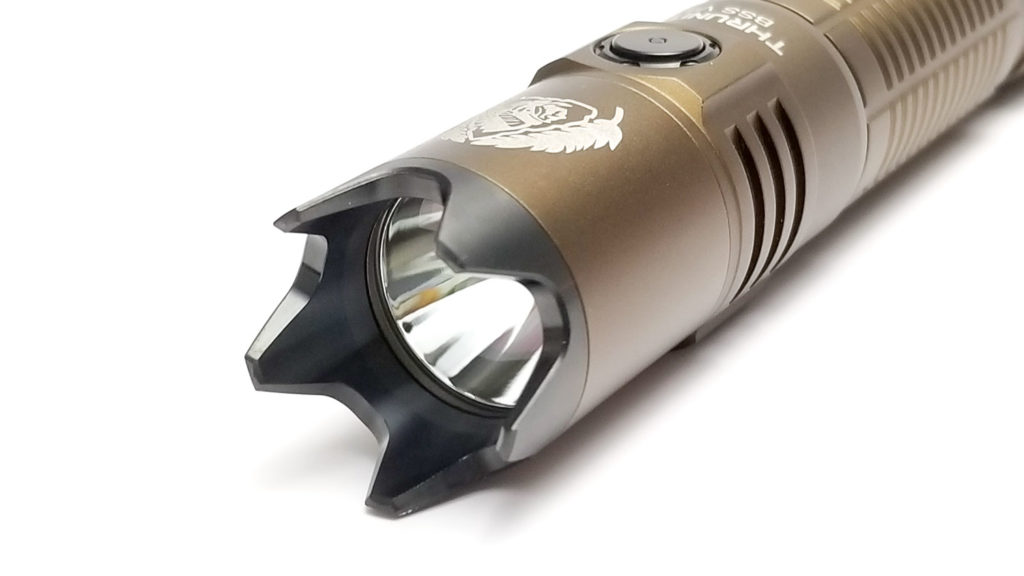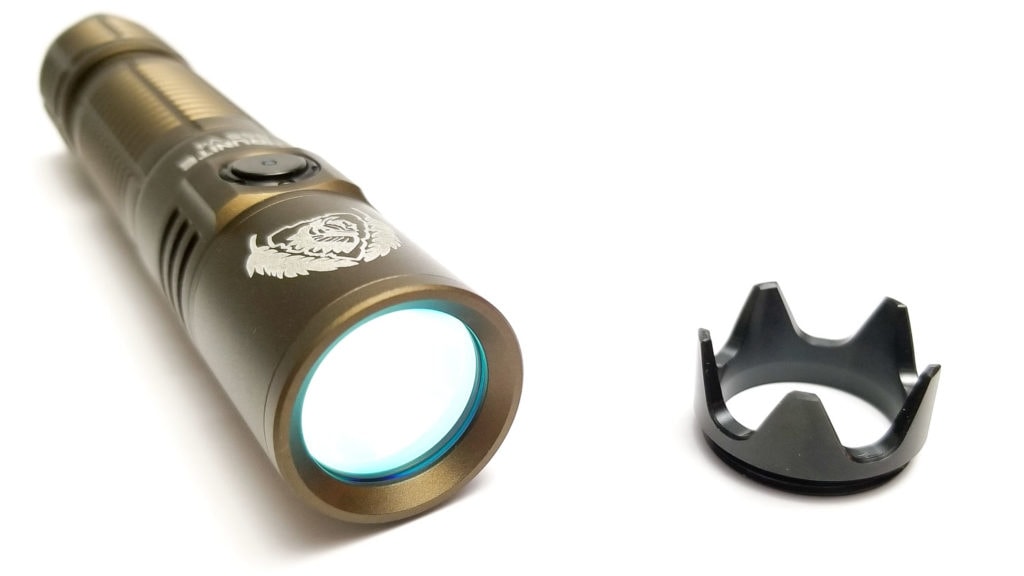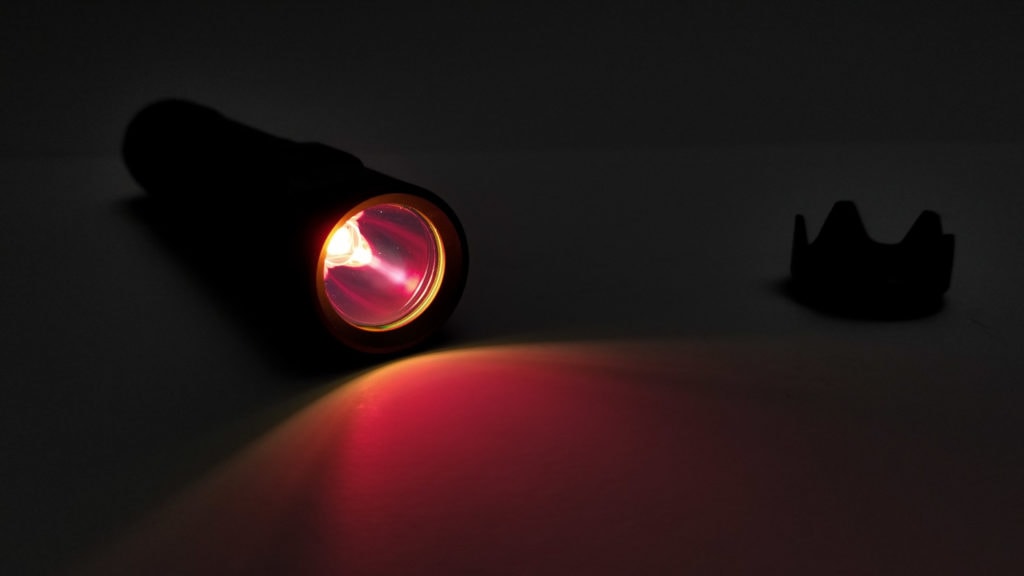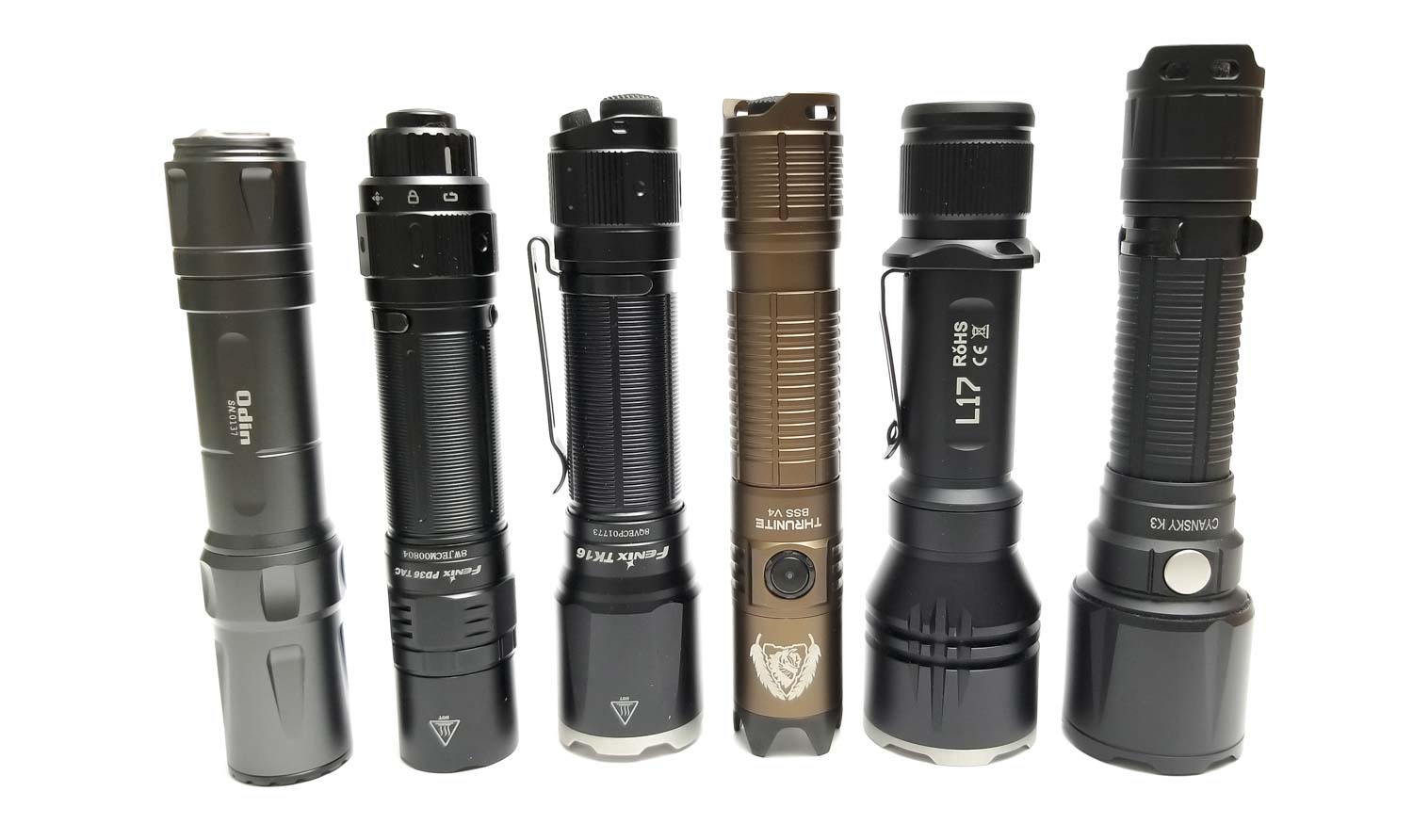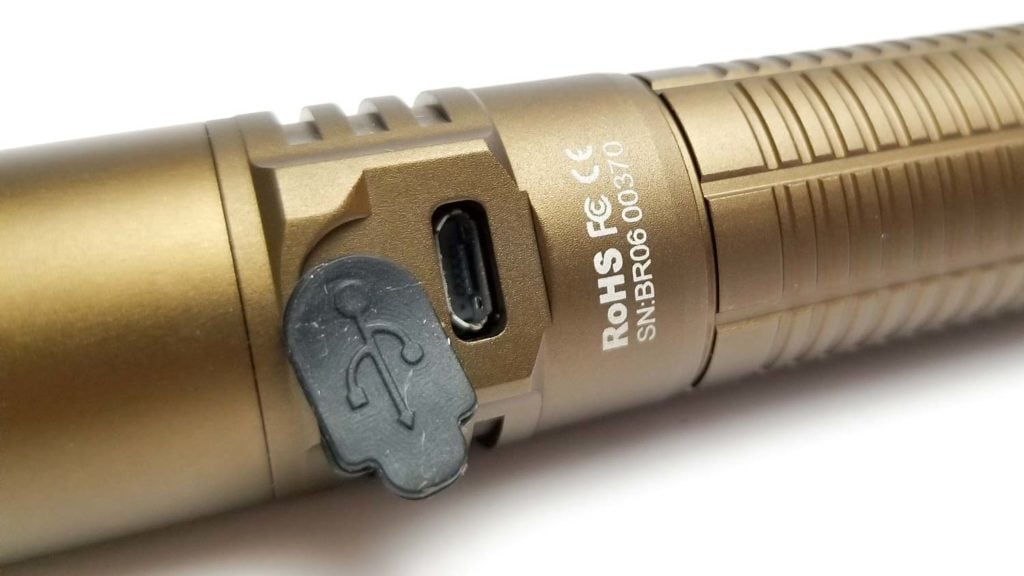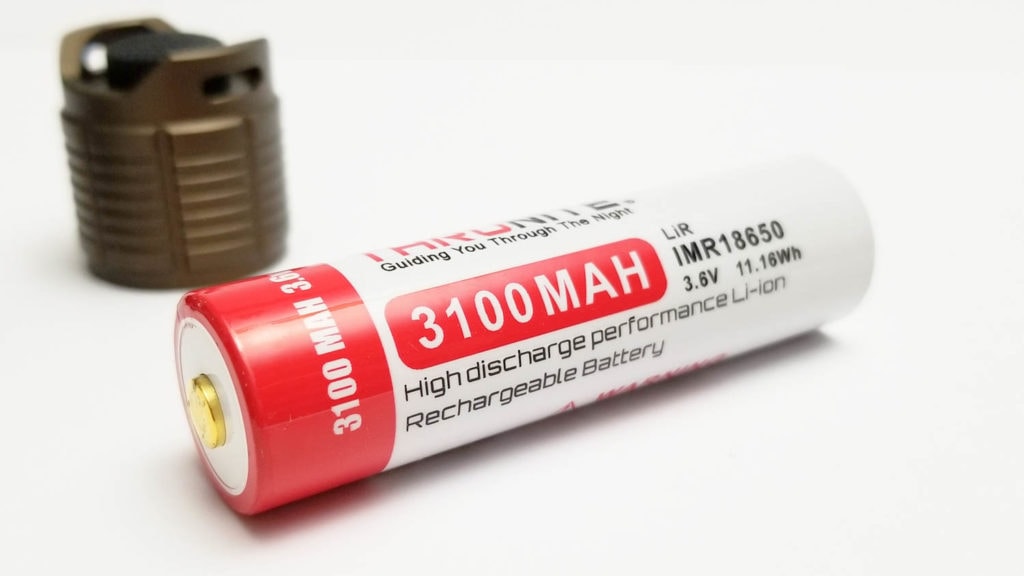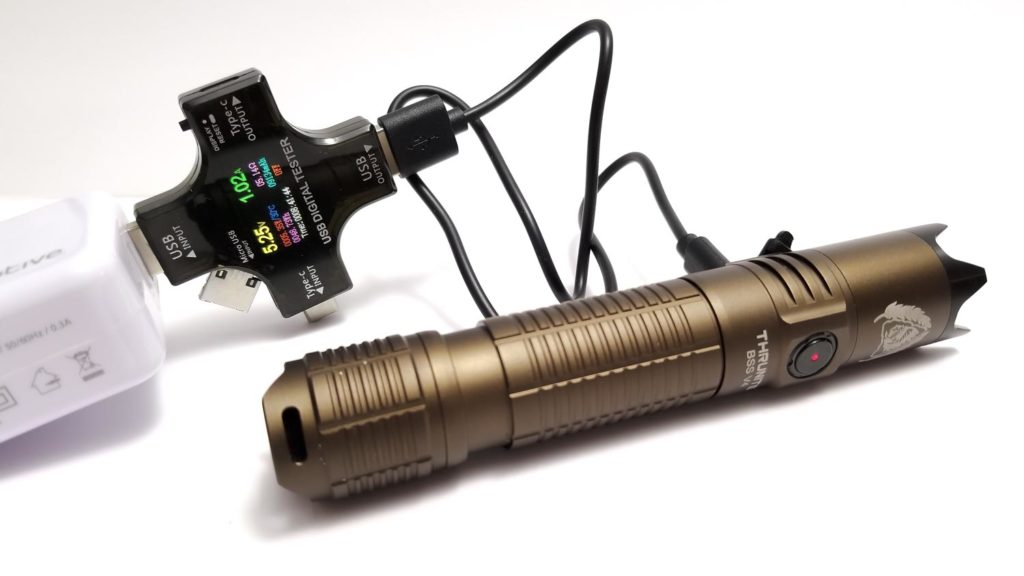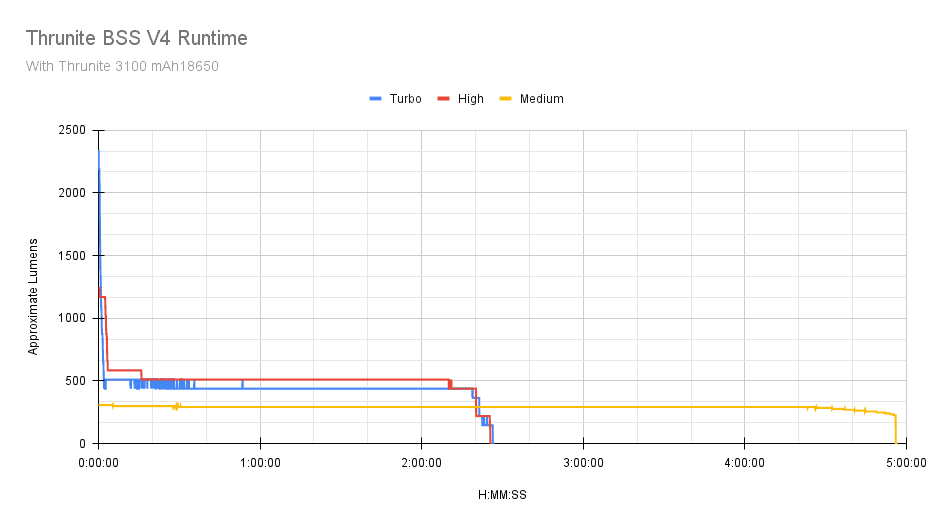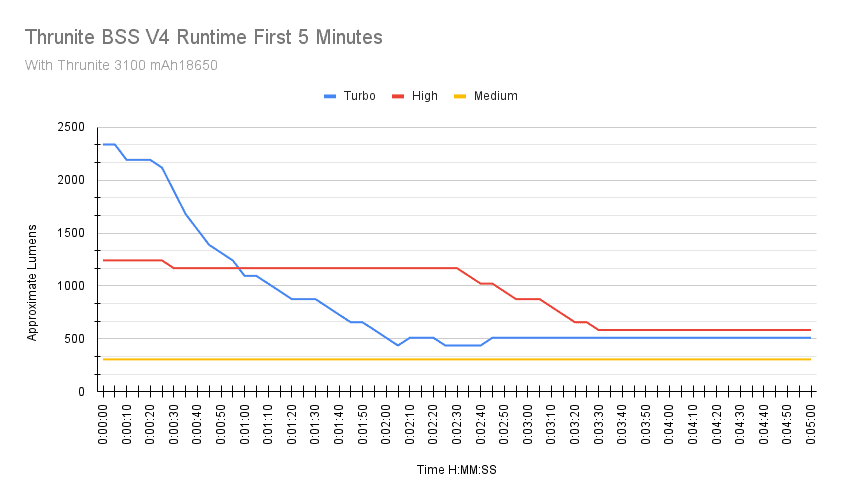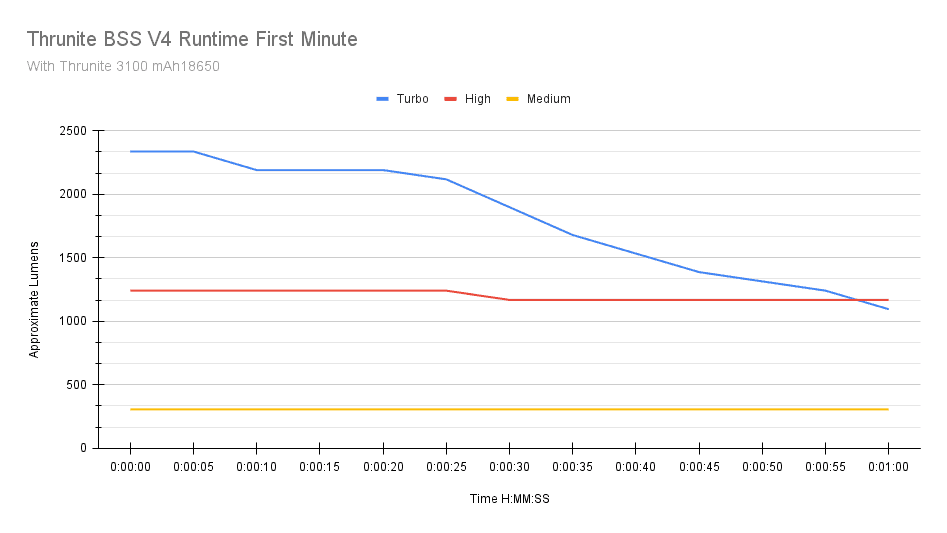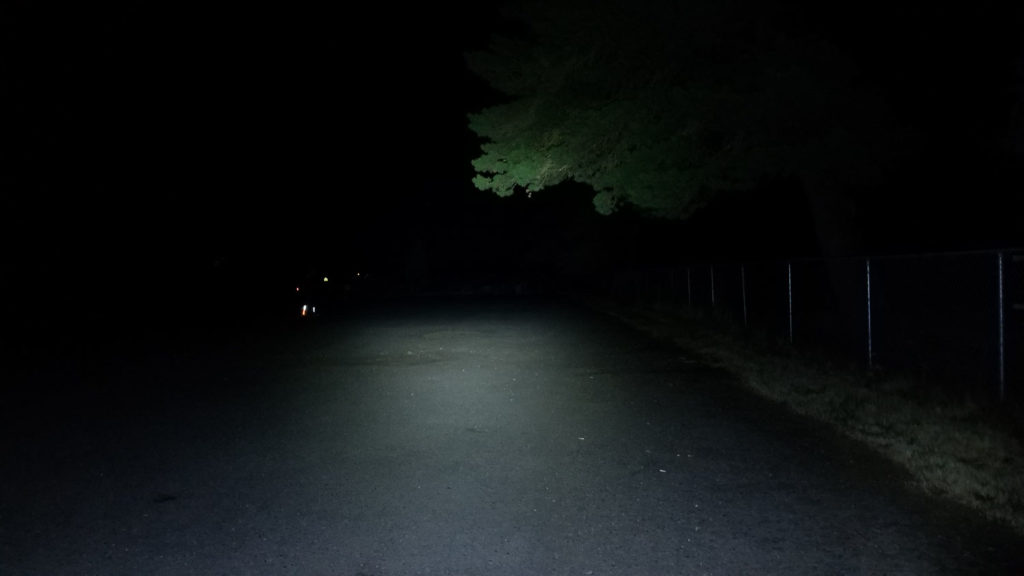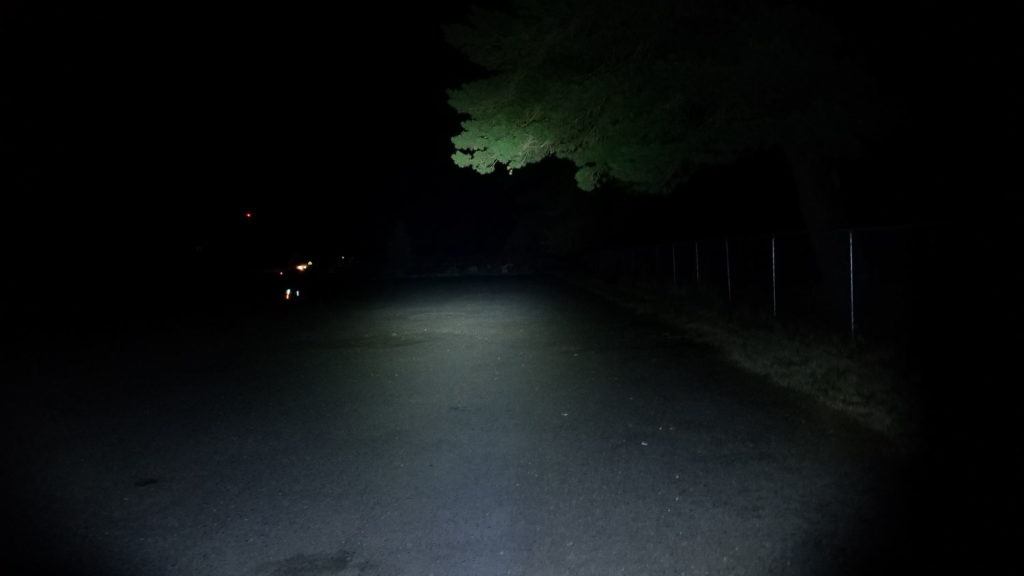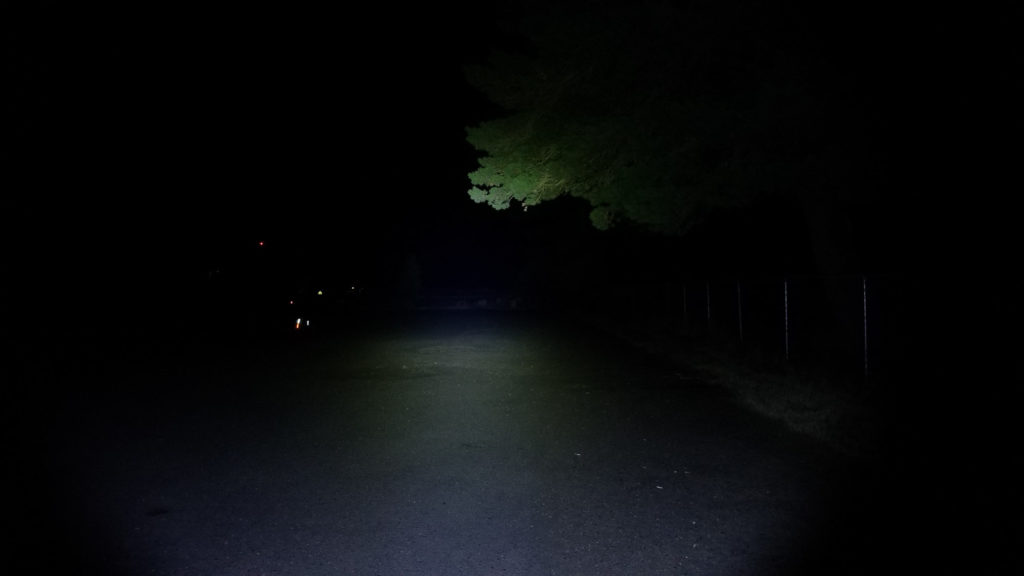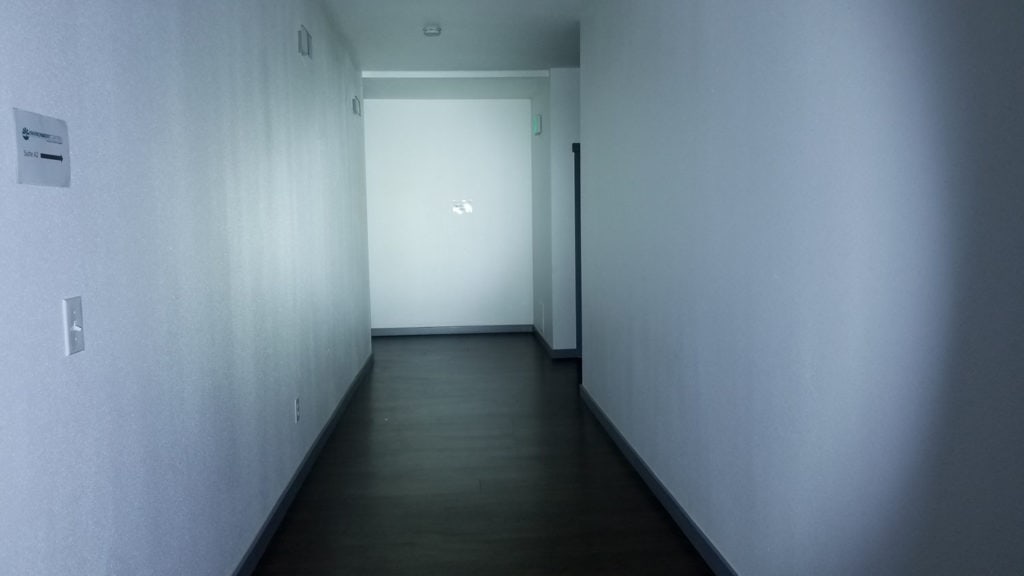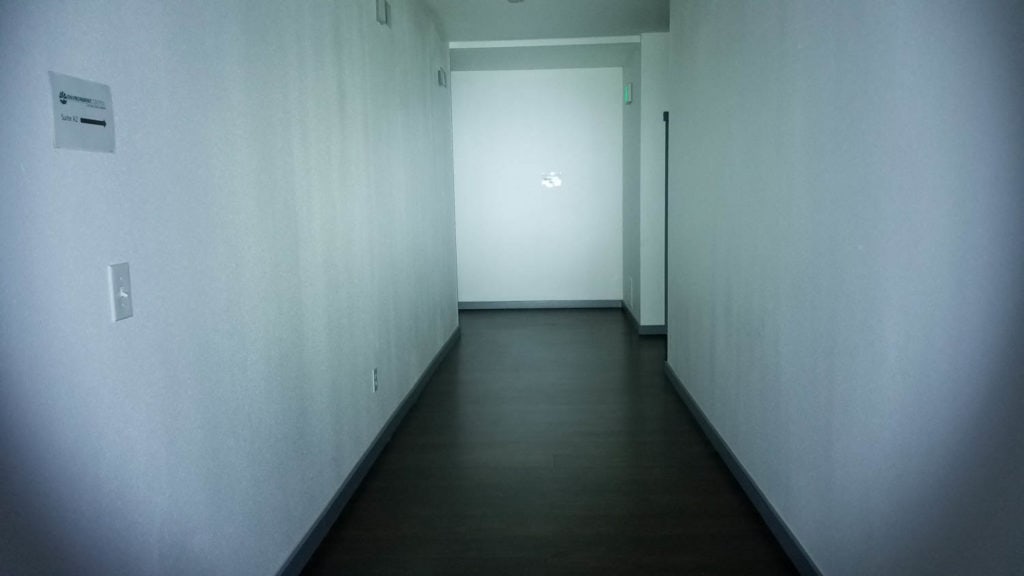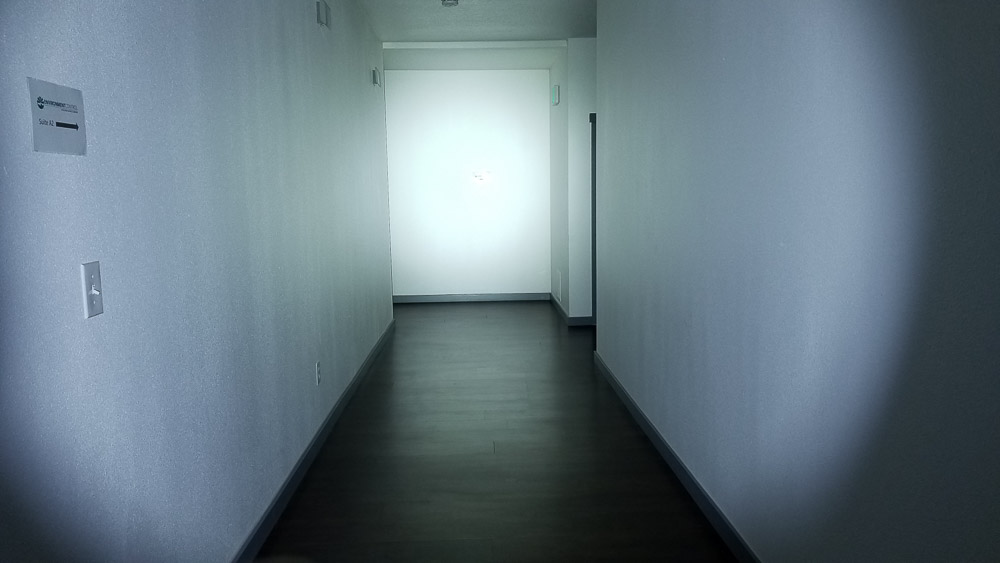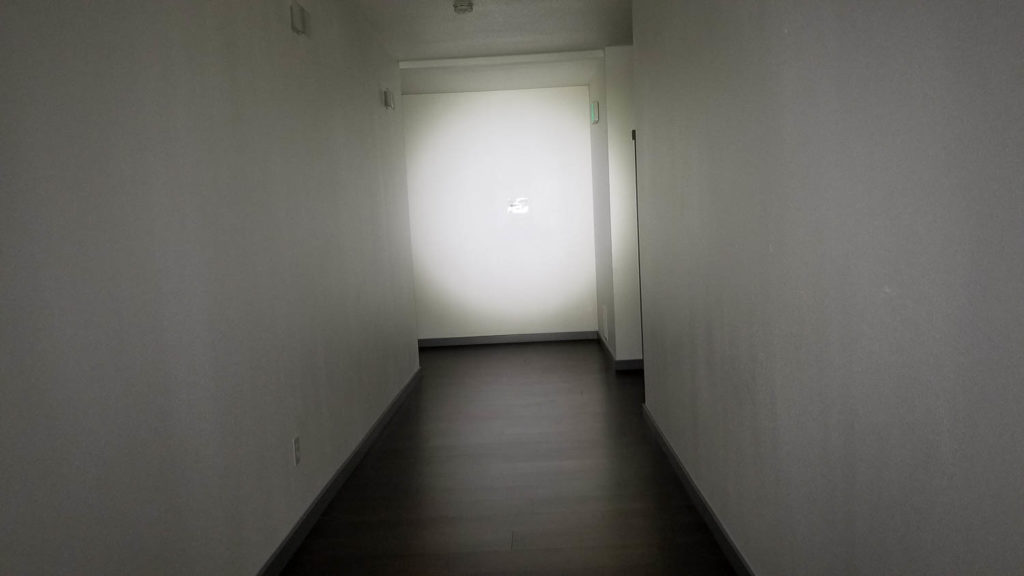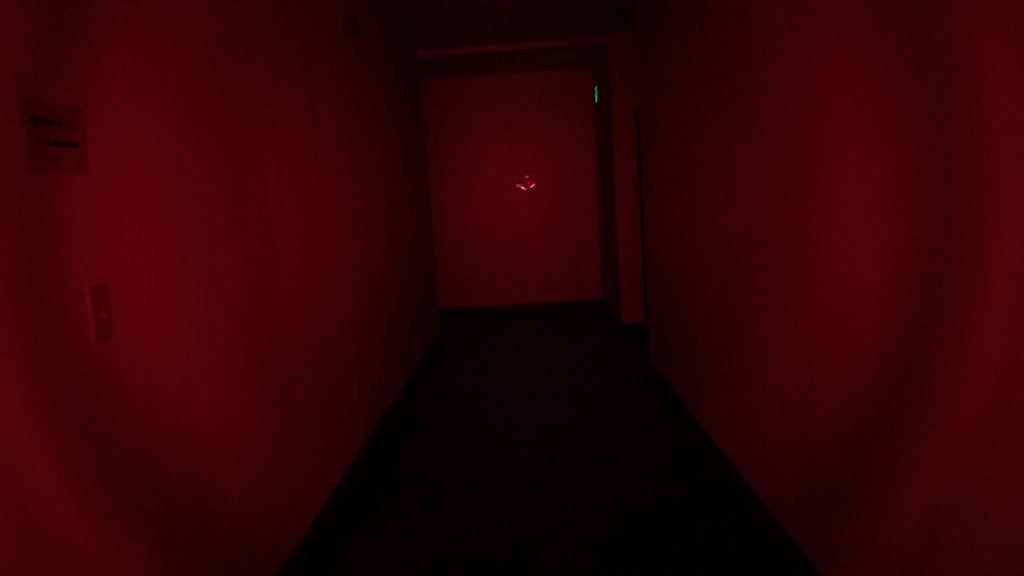1lumen selects and reviews products personally. We may earn affiliate commissions through our links, which help support our testing.
Thrunite BSS V4 review
Thrunite BSS V4 specifications
| Brand/model | Thrunite BSS V4 Tactical |
|---|---|
| Category | Tactical flashlights |
| LED | Luminus SST70 6500K |
| Lumens | 2,523 lm |
| Beam intensity | 15,750 cd |
| Battery config. | 1*18650 |
| Material | Aluminum |
| Modes | 6 |
| Blinkies | Strobe |
| Reflector | Smooth |
| Waterproof | IPX8 |
| Review date | August 2021 |
Introduction:
I had my first exposure to Thrunite when I reviewed the Thrunite TC20 V2 and found it to be about as close as you can get to a “goldilocks” flashlight. What if you’re looking for something a little more tactical? Thrunite has you covered there too with a nice selection of tactical-type lights. However, they’ve mixed it up a little bit and partnered with other enthusiasts to produce co-branded lights. Ever heard of Aquachigger, The Outsider, or Black Scout Survival?
I hadn’t, but apparently those are popular outdoor-action-adventure-survival-themed YouTube channels that have partnered with Thrunite to stick their name/logo on a light and give it a fancy anodizing or theme. Some of these are completely distinct from their regular offerings, but some are just variations of different colors or bundles. For example, Aquachigger has a special W1 and H01 bundle, while The Outsider collection features the H02, TT20, and TC15 in special colors. The Black Scout Survival collection has a tactical theme going with the TW10 pistol light, W1, and a few versions of the V4. I really like this, and it’s great brand exposure for Thrunite (hey, people like YouTube, right?).
Anyway, the ‘star’ of our review today is the Black Scout Survival (BSS)-branded V4. This is an exclusive light made by Thrunite for Black Scout Survival. It’s a tricked-out 18650 semi-tactical light with a wicked strike bezel, slick rear clicky and side switch with a simple UI and solid build quality. Plus, it’s sporting my favorite emitter these days, the Luminus SST70 behind a buck driver. Let’s see if co-branding makes it better, or if it’s a V4 in fancy clothes.
Package quality.
The Thrunite BSS V4 arrived in a pretty simple and all-too-familiar recycled cardboard box with the Thrunite logo and some specs with QR code. It’s a clone of the box TC20 V2 package, even down to the flexible rubber band holding the box halves together. Simpleton boxes aren’t a bad thing and I dig the utilitarian look. The boxtop lifts off to reveal the light inside a LPE bag nestled in microcell foam padding to keep everything safe. Lifting out the light and you can’t immediate see them, but there’s an amazing plethora of accessories hiding under the light, and the adage, ‘everything and the kitchen sink’ definitely applies here:
- Thrunite BSS v4
- 2 spare o-rings
- 2 spare USB charging port covers
- Spare switch boot
- Thrunite-branded 3100 mAh button top 18650 battery (loaded in the light)
- Lanyard
- Simple user manual
- Information card to tightening the head and tailcap
- USB A to micro USB charging cable
- Holster
- Red light filter lens/bezel assembly
- Pocket clip
I don’t know how they crammed all that in there, but this is a fantastic assortment of accessories, easily the most comprehensive I’ve encountered. I mean, name another manufacturer that includes two charging port covers.The accessories look to be good quality, and Thrunite doesn’t cheap out here. I think you definitely get what you pay for (and then some), and including the battery is smart, since a first-time buyer might not have an 18650 lying around (or an appropriate charger). This is in line with other mainstream offerings from other brands as well. The manual was a bit odd. It’s folded like a map and was in English, German, Chinese, and Japanese. It was pretty spartan with just basic operating instructions.
Flashlight in use
The BSS V4 is an 18650 tube light, so it’s smaller (shorter, narrower) than a 21700-size light and doesn’t fill my hands out as well, but it’s still really nice to hold. The body and tailcap has nice milled texturing and a grippy finish. The heft (despite being pretty light) and good balance make for an enjoyable experience. Overhand, underhand, or cigar grip were all easy and intuitive with the V4, and I give kudos to Thrunite for the easy-handling and maneuverability. There’s a dual-switch setup here like a lot of tactical-use flashlights have these days. The rear switch is a traditional mechanical forward clicky for momentary use and only activates Turbo. The front e-switch handles mode switching, access to Moonlight, and a single strobe.
The action on the rear switch is great; nice and snappy with good feel and feedback with the right amount of give and travel before activating. The e-switch, well, needs to go back to switch-finishing school. It’s a metal button and does have an indicator LED in the middle for battery and charge state (it’s not continuously lit when on standby-only when turned or charging), but the action is very low and hard to press, almost feeling like it gets lost in the pad of my finger or thumb. However, once you do get it pressed, it’s not so bad with nice click action and solid feedback. Thrunite included a second bezel with a red filter that screws into the head, so you can swap out the dangerous-looking strike bezel for the filter, or go commando.
There’s multiple retention options with the V4, and this makes the light very versatile. You get a lanyard, pocket clip, and a holster, which is awesome. The clip is a single direction and clips into a milled groove in the body forward of the tailcap. It takes some effort to snap in, and removing it is equally taxing. This is good for security, but bad for your fingernails (trust me). The tailcap features two lanyard mounting holes directly parallel to each other and are adequately sized for the included lanyard, which by the way, is one of my favorite designs besides Skilhunts. It’s adjustable and padded and more importantly, sized for a variety of wrist sizes. The holster allows bezel up or down carry, and can be secured with a carabiner, paracord, other retention device, or mounted on a belt with the belt loop.
Build Quality, and Warranty
I have evaluated lots of lights of varying quality, fit and finish, and one thing that separates the economy brands from the higher-end brands is consistency and attention to detail. Thrunite belongs to the few brands I’ve come to expect their lights to be of consistently good quality for a fair asking price. Retailing for around $60, the V4 is a lot of light for the money. Sure, you can get a Sofirn SP31 Pro for around half the price of the V4, and while the SP31 is a nice light, it’s definitely not on the same level as the V4.
The quality, fit, and finish are as good as it gets for this price, and I don’t see any evidence of cost-cutting in the finishing department. There weren’t any defects in the machining, no burrs or tool marks, and all the parts fit together evenly with no gaps. All the edges are nicely beveled and chamfered, with no sharp edges anywhere. The silk screen text and Black Scout Survival logo was sharp and well done. It also passes the Maracas test; no rattling here.
The light is made from durable 6061-T6 aluminum alloy with a very attractive desert tan (also available in black, digital woodland or gray contrast camo, and gunmetal grey) type III HA anodizing. The finish is matte, and way nicer than the semi-gloss finishes I’ve seen on more expensive lights. It’s not as chalky as the Acebeam and Cyansky finishes I love, but still very nice. It’s perfectly applied also with no blemishes or thin areas. This makes for a nice grippy finish, which is important for outdoor activities when your hands might be wet or slippery. I really like the contrasting black accents in the switch bezel and strike bezel. All very nicely done.
The light cannot be disassembled with the exception of the tailcap (and removable strike bezel). This is a dual-tube setup, with a signal tube (like Lumintop FW’s or Noctigon KR lights) for the e-switch to work with the mechanical switch. The sleeve is spring-loaded, but captured somehow, and when I tried unscrewing the head, it wouldn’t budge, so probably glued or Loctited. The bezel is easily removable and can be swapped out for the included red filter lens.
The tailcap has a dual spring arrangement for maximum current flow. The spring is gold-plated, and the driver side has a brass button for the battery positive contact. The rear threads are good-sized and precisely rectangular cut. The bezel has finer threads, but were still smooth and never seemed like cross threading. The rear threads are not anodized, but you can still lock the light out by unscrewing the tailcap 1/4th turn. Thrunite even includes a note in the box instructing you to tighten the tailcap before use as there was no isolator between the negative end of the battery. Interesting. The threads were lightly lubricated and pretty smooth, but I noticed the tailcap had to go on just right or it would try to cross-thread. The charge port cover has a decent rubber plug for sealing, and the rear threads are sealed with a single o-ring. Thrunite gives the light a generic IPX8 rating, so it should be good for temporary immersion up to 2 meters.
Thrunite is a mainstream brand and stands behind their products, so you get a commensurately robust warranty: 30-days no hassle/haggle free return and refund, 2 year free replacement for factory or manufacturing defects, and a limited lifetime warranty with covered labor for repairs (customer covers parts and shipping). As a bonus, Thrunite extends the free replacement an extra year for registering your product. Nice!
LED, Lens, Bezel, and Reflector
The LED is the Luminus SST70 in cool white (the only tint offered, although the Thrunite website shows a neutral white option, but it’s not available). This LED is one of my favorites, and I’m glad it’s becoming more prevalent in factory lights. It’s a 6 volt or 12 volt LED with 4 dies on a 5×5 mm footprint, so it’s a drop-in (with appropriate boost or buck driver) for the Cree XML, XHP50, or Luminus own SST40. You might be asking yourself, “Nick, why do you like this CW emitter?” Well, it has a very nice beam profile with no angular tint shift, minimal aberrations (even in a SMO reflector), no corona, and it throws great. The LES is 50-60% the size of the XHP50.2, so you get more throw. You can drive it at a lower current to get the same output as a 3 volt XHP50.2 also, so less heat and it’s easier on your batteries.
The LED is paired with a SMO (smooth) reflector topped with a toughened mineral glass lens with AR coating for maximum light transmission. The lens is set back pretty far in the head to make room for the threading for the bezel(s). You get a couple, the aforementioned red filter and the standard-equipment blackened stainless, ultra-gnarly strike bezel with semi-pointy aggressive tips that stick out about 10 mm. I will say it looks slick with the black finish, and even though these strike bezels aren’t my thing, it would be a nice force-multiplier in a self-defense situation or break glass easily. It can be easily swapped though
Thrunite did a good job matching the LED to the reflector. The beam is more flood than throw and lights up a large area. The hotspot is well defined and large with a smooth transition from spot to spill with a wall of light, and I was pleasantly surprised with the uniformity of the beam. Yep, it’s definitely very cool, and a little green as I expected at low power so I didn’t win the tint lottery this time. There’s no anomalies, but with the strike bezel installed, you get an interesting spill pattern in the outline of the prongs. Thankfully, the bezel can be removed. The red filter does the job well, and produces well, red light! It’s not as intense or saturated as a true red 532 nm LED, but good enough to preserve your vision in low-light operations.
Dimensions and size comparison
- Length: 11.9 cm / 6.85 inches
- Head diameter: 4.2 cm / 1.65 inches
- Body diameter: 3.35 cm / 1.31 inches
Weight:
- With 3100 mAh 18650 battery: 242.6 grams / 8.55 oz.
- Without battery:143.2 grams / 5.0 oz.
Flashlight comparison
Compared to some other popular professional-grade tactical lights.
Left to right: Olight Odin WML, Fenix PD36 TAC, Fenix TK16 V2.0, Thrunite BSS V4, Acebeam L17, Cyansky K3
Driver & User Interface:
Thrunite fitted the BSS V4 with a simple UI and a constant-current boost-buck driver (you can use two CR123A li-ion primaries with this light if you so choose). It’s a great combination for output and efficiency since the output is fully regulated throughout the battery life, so you get constant brightness until LVP kicks in.
The UI is delightfully simple and well thought out. It’s basically the same as the one gracing the TC20 V2 adapted for use with a rear forward switch.
Modes: Firefly, low, medium, high, and turbo. There’s a semi-hidden strobe mode also.
From OFF:
- Press and hold side switch: Firefly mode
- Single-click rear switch: Turbo (momentary)
- Single-click side switch: Turns on in last mode
- Double-click side switch: Turbo
- Triple-click side switch: Strobe
From ON:
- Press and hold side switch: Switches to next mode L-M-H-L
- Single-click rear switch: Turbo (momentary)
- Single-click side switch: Turns off
- Double-click side switch: Turbo
- Triple-click side switch: Strobe
Mode memory:
- Yes, last mode memory. Turbo, Firefly, and Strobe are not memorized
Low voltage warning:
- Yes, the switch indicator will flash red when the battery is at 3-2.8 volts. The light will turn off when the cell voltage goes below 2.8 volts. From the manual: 1-10% flashing red indicator, 11-20% solid red, 21-100% solid blue
Strobe/blinkies
- Single strobe at about 5 Hz (incredibly disorientating).
Lock-out mode:
- None. Unscrew the tailcap 1/4 turn to manually lock out.
PWM
- None
Additional info: I think tactical-use should be spelled easy to use because lights like this shouldn’t bog the user down with unnecessary modes, configurations, calibrations, or superfluous blinkies. There I said it. The sword UI’s are great, but on a flashlight for tactical or professional-use lights, it’s a no-no. I’m glad to see that Thrunite has once again loaded the BSS V4 with a simple, but nonetheless effective UI that anyone can quickly master, and the tactical (tacti-cool amongst us) will enjoy. There’s side switch mode switching, and there’s shortcuts to Firefly, Strobe, and Turbo.
You also get instant access to Turbo thanks to the rear switch. When the light is activated with the rear switch, the side switch doesn’t work any more. The single strobe is pretty hidden so you won’t be accidentally activating it, and the mode spacing combined with a true sub-lumen mode is icing on the cake. The mode cycling speed is a little slow for my taste (about a 1 second pause between).
Batteries & Charging
The V4 came with a Thrunite IMR18650 3100 mAh, 11.16 Wh 18650 battery. If you want a spare, Trunite also sells this battery separately. It’s nice to see that this isn’t a proprietary cell, and any flat top or button top will work. I threw in a flat top Sony VTC6 and Sanyo GA, and both worked fine. I was a little worried when the included battery wouldn’t come out of the tube, but a little ‘coaxing’ and it popped out (literally-it’s a tight fit), but my other 18650’s weren’t tight in the tube.
The V4 does have onboard charging, and I was expecting USB C, but nope. Apparently, Thrunite deduced that micro USB was a better choice for the V4. To me, it’s sort of like putting a Blaupunkt cassette player from 1991 in a new Porsche 911 Turbo, so it seems out of place here. Although there’s nothing inherently wrong with the dated connector, I cringe whenever I see one on devices since I’m probably not the only human who’s ever experienced a cell phone that won’t charge because the micro USB port broke or wore out and became an expensive paperweight.
Oh well.
The port is well-protected and sealed and the connection from the included cable is pretty positive. As long as you don’t abuse the connector, it should give good service. One annoying thing: It’s picky about the cable you use. Apparently, the connector is set back in the tube just enough that some of my micro USB cables didn’t reach. The included one does, so you might be stuck with it. On my 2.1 amp wall adapter I got 1.01 amps with a nearly-drained battery. The onboard charging should recharge a flat battery in around 3 hours. Yes, you can keep it plugged into a charger and use it, albeit at significantly reduced output. Thrunite says Firefly and Low are usable while charging.
Performance
This is a pretty standard 18650 tube light, but the emitter and driver give it a huge advantage over an SST40, XP-L, and even an XP-L2 in the output department. I’m expecting a good performance.
Amp measurement
Measuring the current on this light (and any signal tube light) is difficult since you have to jump (or short) the signal tube to the flashlight body while measuring or you won’t get all of the modes. I ended up shorting the signal tube with a piece of solder wick to get the Turbo reading. It’s hard to trust current figures from a boost driver since it’s not the actual output current to the LED. What you see here is the input current from the battery, but here we go
- Firefly: 6 mA
- Low: 45 mA
- Medium: 500 mA
- High: 3.16 A
- Turbo: 6.23 A
Parasitic drain:
- 0.15 mA
Runtime graph
I conducted the runtime test using the 30 centimeter integrating sphere with the Digi-Sense 20250-00 data logging lux meter. I used the fully charged Thrunite 3100 mAh 18650 battery and tested all modes (except strobe, low and firefly.
The Thrunite BSS V4 has a constant current buck driver, so I’m expecting great endurance and consistent output. It will be interesting to see how the thermal regulation holds up though with this small host and 2500+ Lumens.
Turbo started at a respectable 2336 Lumens, and the output didn’t drop much until the 30 second mark, down to under 2000 Lumens. It was a steady decline from there as the host became heat saturated and the thermal regulation kicked in. At the 75 second mark, and by the 120 second mark, the output dropped very low, down to about 500 Lumens where it camped out for the next 22 minutes, then dropped some more. By 24 minutes in, the output was 438 Lumens, and it held there until 2 hours 18 minutes when the LVP started kicking in and dropped the output incrementally. 6 minutes later, the LVP pulled the plug and cut the power very abruptly at the 2 hour 26 minute mark, and just like the TC20 V2, there was no warning other than the tiny blinking switch LED. Thrunite says the light lasts for 125 seconds+147 minutes, or 2 hours 29 minutes (and 30 seconds to be exact). This is the closest I’ve ever got to a factory runtime! Pretty amazing. Heat? Yah, it’s there, and no surprise, it heats up fast. From 26 C ambient to 45 C took 30 seconds, and from there it hit a ceiling at around 15 minutes, right around 48 C, so this is a pretty bare-hand friendly light, even on Turbo. At 30 minutes, the head was 44.8 C and the tube was 40 C, so it appears the thermal limit is set pretty conservatively.
High and Medium were pretty uneventful as I expected. High started at 1241 Lumens, and held that for 25 seconds before a slight step down to under 1200 Lumens. Again, the thermal throttling is pretty low, because by the first step down at 2 minutes 50 seconds, the head was the same temp as Turbo (47 C). The output curve mirrored Turbo by the 16 minute mark when the output dropped to 511 Lumens where it stayed steady for the next hour and 44 minutes. By then the output is the same 438 Lumens as Turbo, and 20 minutes later, another drop as LVP starts really throttling. The last step down happened 5 minutes later at 2 hours 25 minutes, and a few seconds later…shutdown…abruptly. Total runtime? 2 hours 25 minutes and 25 seconds. Thrunite’s time? 150 minutes+130 seconds or 2 hours 32 minutes (and 10 seconds). Pretty close again!
Medium was about as exciting to watch as a professional golf game (I’ve played golf and it’s a lot more fun to play than watch). It started at 306 Lumens, and held that for a hair over 5 minutes before a negligible step down (not visible to the naked eye),to 299 Lumens where it dwelled for the next 4 hours. There was a slight decrease to 284 Lumens, and finally at 4 hours 55 minutes, a final step down before (you guessed it) a hard shut down at 4 hours 56 minutes. Heating was negligible. I actually beat Thrunite’s runtime figure by a whole 26 minutes this time! Their figure is 4 hours 30 minutes.
Buck drivers and boost drivers give you long, consistent regulated output, or laminar output in engineering speak. This is awesome because unlike an FET driver, the output isn’t dependent on the battery voltage, so the light doesn’t dim proportionally to the voltage. Thrunite’s temperature calibration is also pretty conservative, and even on Turbo it won’t burn your hand off. That and the consistent output are testament to careful engineering of the driver and matching it to the LEDs characteristics. In other words, they set the drive current correctly…not too high, not too low. Also, the uncannily-close-factory-runtime figures I got was due to the battery…Thrunite tested the light with their battery, and it’s obviously a quality battery to reproduce similar runtimes. Good job as usual Thrunite. However, it’s not all cherries and whipped cream. I didn’t like the abrupt cutoff with no visual warning (other than the indicator light), nor the fact the light was deader than Elvis Presley and non-functional after the tests. It would have been nice to have at least low or even Moonlight after the tests. Oh, and LVP? Yep, works fine too. 2.9 volts after the tests.
Lumen measurements (for each mode)
For the lumen tests, I used my home made 30 cm integrating sphere calibrated with a light of known output using the Digi-Sense 20250-00 data logging lux meter. I used the included fully charged 3100 mAh battery. Readings were taken at 30 seconds. I captured the turn on reading for turbo.
| Mode | Measured Lumens | Advertised Lumens |
|---|---|---|
| Firefly | N/A no reading | 0.54 |
| Low | 27 | 33 |
| Medium | 306.6 | 350 |
| High | 1241 | 1426 |
| Turbo | 2190 (2336 at start) | 2523 |
Firefly mode was too low for the Digi-Sense to measure, which tells me it probably is sub lumen, or at least close. Overall, this is very good performance from a compact light! Very versatile mode spacing with a very wide range of brightness at your disposal. I’m a little under Thrunite’s turbo spec, but the other readings are on point and more importantly, consistent. For the record, no XP-L2 or SST40 light of similar size could beat the Turbo figure for the BSS V4, even at 30 seconds. This is serious performance thanks to the SST70.
Throw numbers:
Throw was measured at 5 meters indoors using the Uni-t UT383S lux meter. I used the included Thrunite 18650 battery for all tests. Readings were recorded at 30 seconds.
| Mode | Measured Throw | Advertised Throw |
|---|---|---|
| Firefly | N/A | ? |
| Low | 225 cd, 30 meters | ? |
| Medium | 2,500 cd, 100 meters | ? |
| High | 9,825 cd, 198.24 meters | ? |
| Turbo | 14,775 cd, 243.10 meters | 15,750 cd, 250 meters |
Again, Firefly was too low for the Uni-t to measure. Thrunite only listed a single ‘max’ throw figure in the literature, probably turbo. My throw figures look good and again, pretty decent performance for a small 18650 tube light.
Beamshots
I compared the Thrunite BSS V4 to some other tactical-use flashlights: The Olight Odin, Fenix PD36 Tac, Fenix TK16 V2, and a Thorfire C8 with an XHP 50.2 at around 3200 lumens.
- Outdoor shots: The fence is about 95 meters away. The V4 doesn’t throw as far as the others (even the Odin throws more), but it’s still good!
- Indoor shots: The end of the short hallway is about 9 meters. I tried the red filter to see how it works and it does, but not as good as a dedicated red LED.
Disclaimer: This flashlight was sent to me for review at no cost by Thrunite. I have not been paid to review, nor have I been holding back on problems or defects.
Final Verdict
Pros
- Excellent fit, finish and build quality
- Simple and intuitive UI
- High output for a small tube light
- Consistent output and runtimes
- Doesn’t get too hot
- Versatile beam
- Includes lots of accessories
Cons
- Abrupt shut off for LVP
- Micro USB charging
Explanation on star ratings:
1: Avoid: my phone flashlight would be a better choice – 2: Poor: significant defect or issues, much better options available at the same price – 3: Average: some defects or issues – 4: Good: recommended (minor issues) – 5: Great: highly recommended
4.5 stars: ★★★★⋆
Thrunite has been making flashlights for a long time, and it’s reflected in their products. I really like it when manufacturers work with the enthusiast community and partner up for collaboration projects like we have with the Black Scout Survival V4. This is a great all-around 18650 light. It’s compact, easily makes 2300+ Lumens, doesn’t get too hot during extended high output runs, and the beam is nice and versatile, with more output than any SST40 or even XP-L2 light in this class. With the nicely-regulated driver, you get consistent output. Thrunute also doesn’t stick a proprietary battery on you, so smoke if you got ‘em….or use whatever 18650 you want. All this for about $60.
Nice. It’s in the small details that elevate an okay light to a truly great one, and the Thrunite BSS V4 has that. Great handling, nice fit, and finish, for a decent price. As far as 18650 lights go, there aren’t many that do more, better than this one. However, if I could change one thing, I’d put in some kind of visual LVP notification (a blink, blip, something) to supplement the indicator light because the abrupt shut down at the end of the runtime tests were annoying. Also, Thrunite, can we please segue into the 21st Century with USB type C? 4.5 stars for the Black Scout Survival V4. Maybe I’ll check out their YouTube.
ThruNite BSS v4 for sale
1lumen selects and reviews products personally. We may earn affiliate commissions through our links, which help support our testing.
